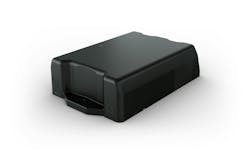Asset tracking is a major component of modern fleet management. Regular, automated location data can help improve operational efficiency and bolster asset security.
Some of the biggest assets that fleets track are their trailers, and the use of trailer tracking is growing in popularity. Paul Menig, CEO of Business Accelerants, told FleetOwner that 20 years ago about 2% of trailers had trackers. Now, about 50% of trailers have trackers.
But what is the benefit of using a tracker, how does trailer tracking work, and what should fleets look for when shopping for a tracking solution?
What fleets should look for
Finding the right trailer tracking solution requires a fleet to look internally. What constitutes a successful tracking program? What tracker data will benefit your operations? How much technology is too much?
“It’s really creating your own asset management journey,” Gail Wong, head of marketing for AT&T IoT Asset Management Solutions, told FleetOwner. “And then go to the various departments and get their goals and objectives and use cases.”
Bryan Dempsey, vice president of engineering for Peterson Manufacturing, recommends fleets pay particular attention to the device's reliability.
“I would say reliability—not only with the device but connectivity as well,” Dempsey told FleetOwner. “From a fleet standpoint, connectivity is a big one, because there’s really no sense in putting a GPS or telematics device in there if it’s not going to work.”
This concerns not only the GPS tracker’s communication capabilities but also the tracker’s cellular plan. A reliable cellular plan, one that can pivot between networks to avoid dead zones, is essential.
How trailer trackers work
Generally, trailer trackers gather GPS location data and then use a cellular network to regularly relay this data to a carrier’s chosen platform.
A GPS tracker uses radio to communicate with GPS satellites and receive its longitude/latitude at specific times. Then, the tracker uses radio to send this data through a cellular network to a carrier’s TMS.
Trackers can also include accelerometers to log changes in velocity or detect potential impacts.
The data collection frequency of a tracker can vary according to a carrier’s preferences. In motion, trackers submit data as often as every 10 seconds. When parked, the tracker might only gather and send location data once a day to save battery power.
Built to last
GPS trailer trackers are generally battery powered, operating reliably for several years. They can also connect to the tractor or a solar panel for extra power. Most trackers use solar energy for reliable power over a long period—often, several years.
“There are device manufacturers with almost 60-amp hours of battery on there and, if it reports once a day, it’ll probably last years upon years,” Wong said. “The majority of what we see for trailers is solar power. You stick it on the front or the top of the trailer. We have many customers seven, eight, nine years now on our network with solar-powered asset trackers.”
A good GPS tracker for trailers will also have an ingress protection rating, keeping its interior electrical components safe from dust or liquids. Trackers typically have an IP67 rating for resistance to dust and water.
Fleets often install their trackers on the roof of the trailer. This makes the tracker more susceptible to damage and weathering but provides the best connectivity and solar power connection.
Data dashboards and reporting
The collection, processing, and display of trailer location data is essential for larger fleets; some of the top 2024 FleetOwner 500: For-Hire fleets manage 6,000 to more than 130,000 trailers.
Most GPS trackers can deliver their data to any TMS through cellular communication protocols. According to Wong, trackers’ location data is formatted for JavaScript object notation (JSON) and communicated through the message queuing telemetry transport (MQTT) protocol.
“As long as they’re using the standard protocols, they [carriers] can ingest that [data] within their platforms,” Wong said.
Shopping for trailer tracking solutions
When choosing GPS trailer trackers, fleet leaders should pay close attention to their operational needs, Wong recommended.
“There’s a mixture of different types of devices out there with different types of price points,” Wong said. “What is the use case? Who needs the data? Some of our fleet safety contacts only want video camera feeds ... versus the fleet maintenance guy wants to be able to know an alert with a report on when big rigs are due 3,000 miles ahead.”
Fleets should also prepare to juggle different technologies across their trailers, and they should know what characteristics and data they need from a tracker.
Juggling different trackers
A fleet’s ideal tracking solution is uniform: Every comparable type of trailer has the same tracker, communicating the same way to the same platform. More often, however, carriers must make do with a patchwork of solutions for their fleets. Carriers need to operate many different types of technologies across their vehicles, and tracking technology is no exception.
Many carriers acquire used trailers from other fleets. Moreover, the service life of a trailer might not align with the service life of an asset tracker.
Leased trailers often see a separate tracking process. Some of these trailers come with their own trackers, which may operate on their own cellular plans. Fleets won’t want to install their own trackers on these trailers just to remove them a couple of years later.
Some trailer manufacturers also offer their own tracking solutions, such as Great Dane and its FleetPulse platform. Other manufacturers’ trailers need aftermarket trackers.
Carriers should be prepared to accommodate a variety of technologies and workflows, as needed, to match the unique circumstances of every trailer.
Part of a smart trailer journey
GPS trackers are one of the most basic technologies to enhance fleets’ trailers. It can also be the first step in a full smart trailer journey.
A fully fledged smart trailer system can include door open/close sensors, reefer temperature, tire pressure monitoring and control, trailer capacity monitoring, and much more.
As carriers look internally to identify their trailer data needs, they would do well to consider whether other forms of trailer monitoring could improve their efficiency and reliability.





